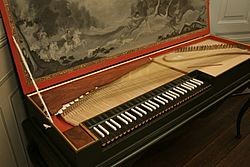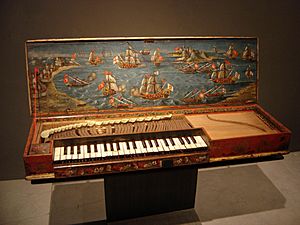Clavichord facts for kids

1977 unfretted clavichord by Keith Hill, Op. 44 (Op. 28 reworked)
|
|
| Keyboard instrument | |
|---|---|
| Hornbostel–Sachs classification | 314.122-4-8 (Simple chordophone with keyboard sounded by tangents) |
| Developed | Early 14th century |
The clavichord is an old European keyboard instrument with strings. People used it a lot from the late Middle Ages through the Renaissance, Baroque, and Classical music times. It was mostly used for practicing music or helping composers write new songs. This is because it was not loud enough for big concerts. The clavichord makes sound when small metal blades, called tangents, hit its brass or iron strings. These vibrations then travel through bridges to a soundboard, making the music.
Contents
What is the Clavichord's History?
The clavichord was invented a very long time ago, in the early 1300s. Around 1504, a German poem mentioned the clavichord. It said that it was one of the best instruments to play along with melodies.
How Do You Play a Clavichord?
To play a note on the clavichord, you press down a key. When you press the key, the other end of it, inside the instrument, moves up. This is like a see-saw. That end has a thin metal blade called a "tangent." The tangent then hits a string. The tangent stays on the string as long as you keep your finger on the key. When you lift your finger, the sound stops.
What Does a Clavichord Sound Like?
The clavichord is a very quiet instrument. Because it was so quiet, it was not good for playing with other instruments. However, it sounds very beautiful in slow, gentle music. Musicians often used it for practicing. For example, harpsichord players or organists would use it at home. This was much warmer than practicing in a cold church!
Clavichords were also small and easy to move. You could even put them on a table. Sometimes, organists would stack two clavichords. This let them practice music written for organs with two keyboards. Some clavichords even had pedals for organists to practice using their feet.
How Was the Clavichord Used?
Many German composers, like Johann Sebastian Bach, wrote music for the "Clavier." This word meant any keyboard instrument. So, players could choose to use a harpsichord, clavichord, or organ.
When the piano became popular in the 1760s and 1770s, people started to forget about harpsichords and clavichords. Today, some people are making these old instruments again. This helps musicians play Renaissance and Baroque music as it was originally heard. This is the music from the time when the clavichord was very popular.
Clavichords in Modern Music
The clavichord has also appeared in newer types of music. This is thanks to the Clavinet, which is an electric clavichord. It uses special parts to make its sound louder for speakers. Stevie Wonder used a Clavinet in many of his famous songs. These include "Superstition" and "Higher Ground." When a Clavinet is played through an instrument amplifier with guitar effect pedals, it often creates a funky sound. This sound was popular in 1970s rock and disco music.
Other artists have also used the clavichord. Guy Sigsworth played it with Björk on her song "All Is Full of Love." Björk also played the instrument herself on "My Juvenile" from her 2007 album Volta. Tori Amos used the clavichord on her songs "Little Amsterdam" and "Smokey Joe." She also featured the Clavinet on "Not David Bowie."
Images for kids
See also
 In Spanish: Clavicordio para niños
In Spanish: Clavicordio para niños







